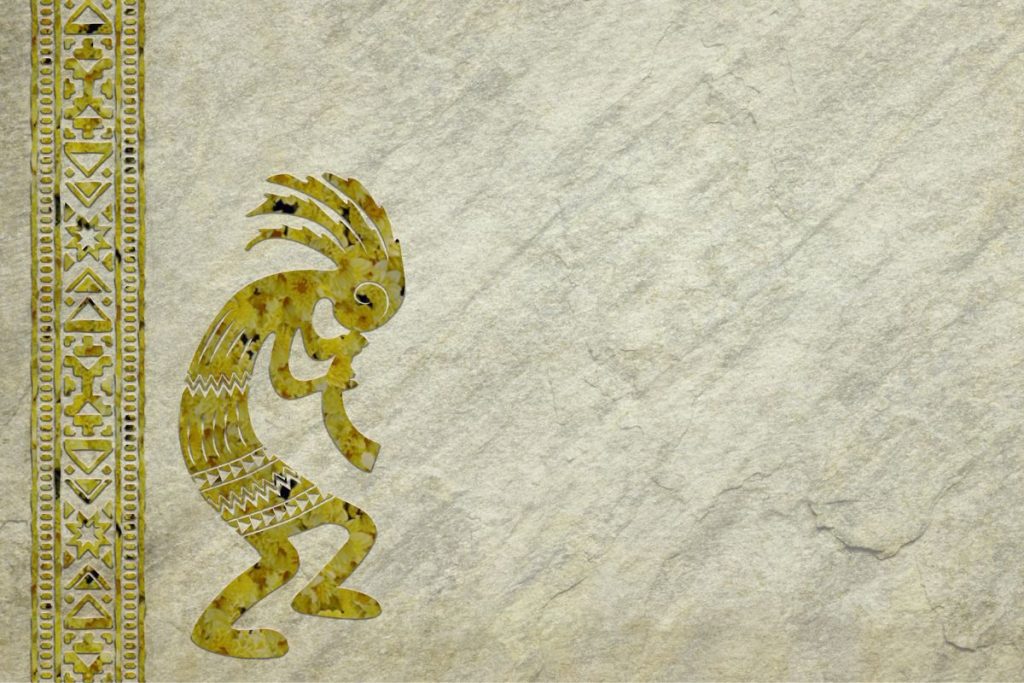The Kokopelli symbolizes fertility, growth, joy, and storytelling among Native American tribes in the Southwest United States.
Kokopelli Meaning
| Symbolic Meaning | Fertility, growth, joy, storytelling |
| Appearance | Flute-playing fertility god carrying a sack |
| Origin | Over 1,000 years ago on Hohokam pottery |
| History and Use | Native American culture and religion |
What Does the Kokopelli Symbolize?
The Native American deity Kokopelli is the god of fertility or the symbol of fertility. He is also the symbol of good luck, music, and merrymaking.
Kokopelli Origin
The portrait of Kokopelli has a lot to do with his symbolism. It was believed that Kokopelli originated as a portrayal of the Aztec traders who journeyed with a sack carried on their backs.
Symbolism
This flute-playing god symbolized fertility due to the sack he carried on his back. People believed that the sack he carried was full of seeds which, when planted, ensured abundance. This depiction is portrayed in prehistoric art, music, and culture.

Rainbow Symbolism
The sack he carried had rainbows, again the symbol of happiness and vitality. There is also a rainbow-colored version of the Kokopelli, which symbolizes a life full of happiness, beauty, and successful relationships.
Fertility & Liveliness
Further, it’s believed that the flute he carried was to court young women and made them fertile. According to some natives, his flute was so powerful that it would melt the snow and initiate the beginning of spring. And as we know, spring is the season of abundance and happiness.
As the deity of music and merriment, he symbolizes the idea of enjoying life during festivals. Also, people considered him as the muse who inspired creative people to produce literature, songs, poems, and other imaginative creations.
Darker Symbolism
Even though there is a lot to admire and praise about Kokopelli, some darker symbols are associated with him. Some Native Americans considered him a trickster God or a swindler. When women fail to conceive or crops fail, people blame Kokopelli as the trickster.
Others believe that Kokopelli lures us with his melody and leaves us behind in the chaos.

Kokopelli Appearance
The image of this flute player deity was also popular in the Anasazi Indian mythology, and he was a character among the Hopi legends.
Same Basic Image
Kokopelli has different avatars based on varying cultural representations. However, the base image is the same for every variation.
- Portrayed as a flute player with a humpback
- Sometimes described as an erect phallus (due to being the fertility god)
- Sometimes contains antenna-like protrusions on the head
- Some images of him have deformed physical structures like knobby knees, club feet, permanently erect phallus
Kokopelli Symbol’s History And Use
The deity first came into notice around 500 A.D and 1345 A.D, and he was considered a predominant religious figure. Even now, some Southwestern native American tribes worship Kokopelli.
Apart from being the primary native American symbol, different cultures have used the Kokopelli.
Kokopelli Symbol In Rock Art
During 1000 AD, figures similar to Kokopelli with a hunchback and wielding flute were commonly seen as petroglyphs in Puebloan culture.
Kokopelli, A Deity in Hopi Culture
A deity similar to Kokopelli was popular among Hopi and in the American Southwest. The Kokopelli figure they carved was similar, with feathers in his hair, a rounded back, and a flute.
Hopi Anasazi were an ancient American group of an ethnic tribe who lived years ago in the four corners of the Southwestern United States (Colorado, Arizona, New Mexico & Utah).
Archeologists believe that Kokopelli, the humpbacked flute player, was not the symbol of a single culture or tribe. Ancient people around different world cultures worshiped the image of Kokopelli as a deity of fertility, growth, abundance, joy, and merrymaking.

